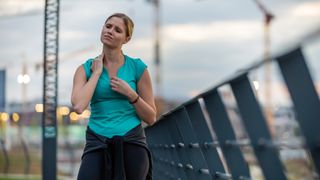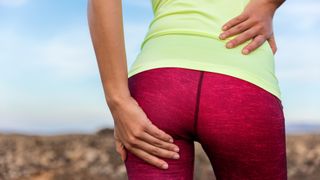How to stop chafing when running and hiking: lubrication, prevention and more
Here's how to stop chafing, as it can quickly cut short a run or hike, leaving you in extreme discomfort for days

Knowing how to stop chafing is more important than you might at first think. It’s hardly a medical problem to present with at ER, but nevertheless, rubbing issues out on the trails can put you in world of pain. In other words, knowing how to stop chafing could improve many people's active lives. Outdoor gear is increasingly designed to minimize the problem but, even with the very best hiking boots, trail running shoes and best base layers, chafing can still be an issue.
Just in case you’ve been lucky enough never to have experienced it personally, let’s start with a definition: chafing is irritation caused by repetitive rubbing of material on skin. It afflicts people in different areas (nipples and nether regions are, unfortunately, often the worst hit places, leading to all sorts of embarrassing contortions and wardrobe adjustments as you attempt to deal with the drama). A heavily loaded hiking backpack can cause severe chafing, especially around the hips and even on models with a heavily padded waist belt. Chafing is also the route cause of common problems such as blisters and hot spots. Its effects can range from mild discomfort to teeth-gritting agony. Knowing how to prevent blisters is just one battle in the war against avoiding chafing.
How to stop chafing: top 5 tips
- Pre-lube. Mid-lube. Always lube. Love the lube. And always carry spare lube.
- Test your clothing for hot spots before run or long hike. Opt for wicking fabrics where possible and test what kind of materials work best against your skin – synthetic (i.e. capilene, polypro, lycra), natural (merino wool, bamboo) or a mix.
- Use seamless or flat seam gear especially base layers and socks.
- Pre-test your other kit – shoes, backpacks, run belts – for fit and function on your body before running or hiking long distances. Make sure you pack your backpack as you would for a long outer; your load and how it sits will affect whether you chafe or not.
- Work out what kind of lube works for you – synthetic or natural.
Feel the burn
So, what’s chafing like and when might it strike? Let’s continue with a cautionary tale: a runner, let’s call him Beau (because that’s what his name is), is running through the countryside, feeling on top of the world sporting his trail running sunglasses and pushing for a PB, when he notices that his nipples are tingling. Soon, they feel like someone is holding a flame to them. Then he notices blood seeping through his top, roughly where his nipples are. Now in considerable pain, he stops, inspects and realises that he has a case of nipple chafe for the record books. They are red raw. Looking around, he spies a barbwire fence and figures on a salve… of sorts.
Ten minutes later, a farmer ploughing his paddock on a tractor is confronted by a man running by with rough-hewn circles cut out of his shirt. The barbwire worked wonders as a bush blade to free bleeding nipples from being chafed to oblivion. The breeze on Beau’s exposed nipples is somewhat soothing – if too little, too late. His end-of-run shower is going to sting, no matter what. Perhaps next time Beau heads out, he should also read up on trail running injuries and how to avoid them too, just for good measure.
You may not have resorted to cutting out nipple holes in your running top, but the first part of this story will be familiar to many runners and ramblers. Plenty of outings have been curtailed earlier and more painfully than planned due to red-raw rubbing injuries.
How to stop chafing – here's the rub

So, how to stop chafing? Why does it happen? It’s all about moving parts – your moving parts rubbing over time against other moving parts and materials. Friction + repetition + moisture = pain. Intense pain.
The causes are manifold: a new top made from a different mix of materials, an ill-fitting boot or shoe, the seam of a pack on your back, the strap across your chest, the fold of fabric under your arm. Sometimes it’s just our strangely shaped body bits not conforming to how sports kit designers perceive their market to be.
Advnture Newsletter
All the latest inspiration, tips and guides to help you plan your next Advnture!
It can be about clothing too tight. Or too loose. It can be about an errant seam. Or even your backpack being stuffed unevenly because you're not sure how to pack a backpack effectively. It’s also about conditioning – what your body is used to doing, and wearing.
And it’s about the conditions – chafing problems are especially prevalent when it’s humid, and in other situations where sweat and moisture accumulates – because that introduces salt into the mix, literally rubbing it into your wounds.
So, just because a top or baselayer or boot hasn’t caused you problems in the past, that doesn’t mean it never will, especially if you wear it in different conditions.
How to stop chafing and prevent the pain
Knowing how to stop chafing before it occurs is half the battle. Prevention is always better than cure – especially given the only cure for chafe is quitting your endurance mission and giving your skin time to heal.
There are three factors that stop chafing: wearing the right gear; lubing up; and stopping the repetition (but that would require not running or hiking). So it comes down to reducing the friction by either applying a lubricant or wearing kit that doesn’t rub.
Some people may also argue that acclimatisation and adaptation play a role: that is, changing how your body deals with the causational factors of chafe to mitigate the onset. This means in a physiological sense, you body coping with humidity better, sweating less, or thickening and hardening of skin in chafe-prone areas, especially on the feet.
How to stop chafing by lubing up
The secret sauce to avoiding the rub is lubrication – AKA ‘lube’. The approach most commonly employed in the battle against the burn is the application of a lube such as Vaseline, TriSlide, Squirrels Nut Butter or Bodyglide, or a microlayer barrier cream alternative like ChafeX. These, and a bunch of other brands, are the foundation of any good anti-chafe strategy. Slap it on liberally, and everywhere. Yes, even there – the nether regions being particularly prone to painful problems.
It’s important to test your choice of lube out in a non-critical situation, such as during a training run close to home, and in conditions you will be running or hiking in when you need it to work. If you’re training for an event or hiking experience somewhere that’s hot and humid, try and test your lube of choice in such conditions, to see how it performs.
Not all lubes are created equally, or for any one individual. Think about what the lube is made of and, importantly, what may irritate your skin in terms of ingredients. Also be mindful of how it is applied, what container it comes in, and whether it is made of all natural ingredients or synthetic.
Small sachets are great for stashing in your backpack or hydration pack for on-the-run application, but they can leak (and, you know, single use plastic and all that). Tubs are great for pre-application in your bathroom, but not great for sharing (think about it – your hands in the pot, to your nethers, back to pot… who wants to share that?!).
Aerosol application is great for sharing, but requires a lube solution that includes synthetics and chemical additives. A solid bar of lube is great for the no-leak factor and small size for easy pack away, but again the caring is in the not sharing, given direct contact with all sorts of bodily bits.

How to stop chafing via material gains
The fabric you wear next to your skin is clearly very important in preventing chafing trouble. Everyone reacts differently to different materials, and what’s good for the goose might not be good for the gander. But, as a rule, fabrics that wick sweat away from the body are better than those that don’t.
Merino wool is a magic material with sensational wicking properties, among many other adventure-friendly attributes, including wonderful next-to-skin comfort. Some people, however, might be allergic to wool, and of course it won’t suit vegans. It also works out quite expensive to have a merino top for every outdoor occasion, if you’re a regular runner, hiker or biker. Other natural fibres, such as bamboo, are also very comfy. See how you get on with synthetics, but once again, make sure you trial your gear during training walks/runs, instead of during a long hike or on race day.
How to stop chafing – hot spots
It also pays to think about all the areas of your body that can be prone to chafe – some people get it everywhere (particularly prolific sweaters), while others have only one problem area. Places susceptible to chafe are usually where moisture accumulates and there is contact with material or lots of skin-on-skin rubbing, including feet, bum, underarms, back, inner thighs, crotch, and nipples.
When it comes to nipples, feet and toes – many people swear that taping up is the best prevention method. Be extra cautious, however, as sometimes this can worsen the issue with tape creasing on the move and exacerbating the rub. Again, try it out extensively before you’re in a situation when it really matters.
Minimising the moisture factor can also contribute to better chafe management. Sweat in humid conditions is hard to avoid (unless you live somewhere that’s constantly hot and humid, or you specifically acclimatise your body’s heat regulating system, which is possible but means going to great lengths of heat chamber training). You can, however, manage that moisture by wearing clothing that wicks the sweat away from your body, and that dries quickly. However, if you are someone who both sweats heavily and loses a lot of sodium through your pores, that salty remnant can dry as a white crust on your body and clothes, and create a rub factor of its own.
Reducing moving parts is another important prevention tip. Pre-test all your gear before trusting it on long forays. Chest straps, bags on back, socks against shoes against feet, shorts, and material types (synthetic versus natural) are all things to consider and experiment with on shorter outings before undertaking the big missions.
Too little, too late

What about those times where you feel a hot spot start to burn mid-run or hike? The key here is to make the determined decision to stop as soon as you feel a minor tingle, in order to take action to prevent it getting any worse. Do not leave it even for a few minutes, as there is a point of no return that comes on quickly. Apply lube and, if you have to, consider a topical bandage or second skin-type product (assuming you have some in your first aid kit, which you should). Applied with care, these can sometimes mitigate the onset of the blister or minimise chafing, if it’s caught early.
And if it’s too late, and you need a last resort – keep an eye out for a barbwire fence, be prepared to ruin your clothes, and banish the burn with a little fresh air. Just be mindful of what you are flashing the farmer as you pass by.
Australia-based Chris mastered his outdoor gear reviewing technique as an editor of outdoor and adventure magazines, including Walk (UK), Outer Edge and Trail Run Mag (Australia), and as a contributor to the likes of Australian Geographic Outdoor, Wild, Adventure NZ, and Lonely Planet adventure titles. He mostly knows what he's doing. Apart from that time he was helicoptered out of the Bhutanese Himalayas. Or evacuated from the Australian desert to hospital. Or... well, let's say he tests his gear with gusto.

